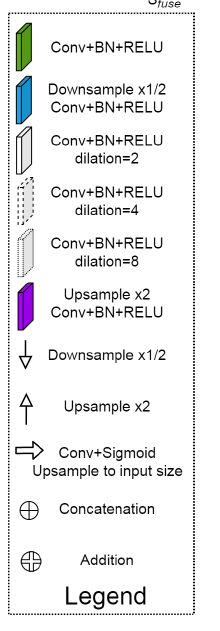图像分割实战-系列教程10:U2NET显著性检测实战2
发布时间:2024年01月05日

🍁🍁🍁图像分割实战-系列教程 总目录
有任何问题欢迎在下面留言
本篇文章的代码运行界面均在Pycharm中进行
本篇文章配套的代码资源已经上传
5、残差Unet模块

class RSU7(nn.Module):#UNet07DRES(nn.Module):
def __init__(self, in_ch=3, mid_ch=12, out_ch=3):
super(RSU7,self).__init__()
self.rebnconvin = REBNCONV(in_ch,out_ch,dirate=1)
self.rebnconv1 = REBNCONV(out_ch,mid_ch,dirate=1)
self.pool1 = nn.MaxPool2d(2,stride=2,ceil_mode=True)
self.rebnconv2 = REBNCONV(mid_ch,mid_ch,dirate=1)
self.pool2 = nn.MaxPool2d(2,stride=2,ceil_mode=True)
self.rebnconv3 = REBNCONV(mid_ch,mid_ch,dirate=1)
self.pool3 = nn.MaxPool2d(2,stride=2,ceil_mode=True)
self.rebnconv4 = REBNCONV(mid_ch,mid_ch,dirate=1)
self.pool4 = nn.MaxPool2d(2,stride=2,ceil_mode=True)
self.rebnconv5 = REBNCONV(mid_ch,mid_ch,dirate=1)
self.pool5 = nn.MaxPool2d(2,stride=2,ceil_mode=True)
self.rebnconv6 = REBNCONV(mid_ch,mid_ch,dirate=1)
self.rebnconv7 = REBNCONV(mid_ch,mid_ch,dirate=2)
self.rebnconv6d = REBNCONV(mid_ch*2,mid_ch,dirate=1)
self.rebnconv5d = REBNCONV(mid_ch*2,mid_ch,dirate=1)
self.rebnconv4d = REBNCONV(mid_ch*2,mid_ch,dirate=1)
self.rebnconv3d = REBNCONV(mid_ch*2,mid_ch,dirate=1)
self.rebnconv2d = REBNCONV(mid_ch*2,mid_ch,dirate=1)
self.rebnconv1d = REBNCONV(mid_ch*2,out_ch,dirate=1)
def forward(self,x):
hx = x
hxin = self.rebnconvin(hx)
hx1 = self.rebnconv1(hxin)
hx = self.pool1(hx1)
hx2 = self.rebnconv2(hx)
hx = self.pool2(hx2)
hx3 = self.rebnconv3(hx)
hx = self.pool3(hx3)
hx4 = self.rebnconv4(hx)
hx = self.pool4(hx4)
hx5 = self.rebnconv5(hx)
hx = self.pool5(hx5)
hx6 = self.rebnconv6(hx)
hx7 = self.rebnconv7(hx6)
hx6d = self.rebnconv6d(torch.cat((hx7,hx6),1))
hx6dup = _upsample_like(hx6d,hx5)
hx5d = self.rebnconv5d(torch.cat((hx6dup,hx5),1))
hx5dup = _upsample_like(hx5d,hx4)
hx4d = self.rebnconv4d(torch.cat((hx5dup,hx4),1))
hx4dup = _upsample_like(hx4d,hx3)
hx3d = self.rebnconv3d(torch.cat((hx4dup,hx3),1))
hx3dup = _upsample_like(hx3d,hx2)
hx2d = self.rebnconv2d(torch.cat((hx3dup,hx2),1))
hx2dup = _upsample_like(hx2d,hx1)
hx1d = self.rebnconv1d(torch.cat((hx2dup,hx1),1))
return hx1d + hxin
这里以RSU7举例,U2Net就是每一个backbone都是一个带残差连接的Unet,这些backbone再以Unet的形式进行连接,在连接的过程中有特征凭借和上采样下采样操作
- 首先这里的RSU7也是一个一个相同的小组件组成,每一个小组件都是一个REBNCONV
- 一个REBNCONV就是,一个卷积Conv、批归一化BatchNormalization、Relu激活函数的三连
- 在构造函数中,就是定义了1个REBNCONV+5个(REBNCONV+Maxpooling)+8个REBNCONV
- 其中第一个REBNCONV是为了进行残差连接,将输入的长、宽、通道数转化为和输出一直的维度,代表原始输入的x
- 在最后的输出会再加上这个x,表示残差连接操作
- 编码器就是5个(REBNCONV+Maxpooling)和最后一个没有Maxpooling的REBNCONV,即hx1到hx6
- hx7是中间结果
- 解码器就是5(对应位置进行拼接的REBNCONV+上采样)和最后一个没有上采样的REBNCONV,即hx6d到hx1d
- hx1d再加上前面提到的x就是最后的输出
6、上采样操作与REBNCONV
def _upsample_like(src,tar):
src = F.upsample(src,size=tar.shape[2:],mode='bilinear')
return src
使用双线性插值进行上采样操作
class REBNCONV(nn.Module):
def __init__(self,in_ch=3,out_ch=3,dirate=1):
super(REBNCONV,self).__init__()
self.conv_s1 = nn.Conv2d(in_ch,out_ch,3,padding=1*dirate,dilation=1*dirate)
self.bn_s1 = nn.BatchNorm2d(out_ch)
self.relu_s1 = nn.ReLU(inplace=True)
def forward(self,x):
hx = x
xout = self.relu_s1(self.bn_s1(self.conv_s1(hx)))
return xout
定义二维卷积、二维池化、Relu,然后进行对应的前向传播
7、各个残差Unet比较
在 U2-Net 中,RSU7, RSU6, RSU5, RSU4, 和 RSU4F 是用于构造网络不同层级的模块。它们共同构成了 U2-Net 的多层次特征提取体系
-
RSU7 (Residual U-Block 7):
RSU7是最深层的模块,具有最大的感受野,用于网络的最初阶段,用于从输入图像中提取基础和全局特征。在U2NET架构中,RSU7作为第一个阶段使用。
-
RSU6, RSU5, RSU4:
- 这些模块是 U2-Net 架构中的中间层。
RSU6,RSU5,RSU4的主要区别在于它们的深度和感受野的大小。每个模块都比前一个模块浅一点,感受野也稍小。这些层用于提取越来越具体的特征,随着网络的深入,这些特征越来越侧重于局部细节。
- 这些模块是 U2-Net 架构中的中间层。
-
RSU4F (Residual U-Block 4-Full):
RSU4F是一种特殊的 RSU 模块,它不使用最大池化层来减少特征图的尺寸,而是使用不同膨胀率的卷积来增大感受野(即空洞卷积),RSU4F用于网络的深层,用于捕捉更细粒度的特征。
在 U2-Net 的结构中,这些 RSU 模块按照从 RSU7 到 RSU4F 的顺序排列。
在编码器阶段,随着层级的增加,模块逐渐变得更浅,专注于更细节的特征提取。
在解码器阶段,这些模块的输出与对应编码器阶段的输出进行融合,通过上采样逐步恢复图像的空间维度,同时保持了特征的丰富性。
总结来说,RSU7 到 RSU4F 的不同主要在于它们的深度(层数)和膨胀率,这影响了它们的感受野大小和特征提取的具体性。
文章来源:https://blog.csdn.net/weixin_50592077/article/details/135398229
本文来自互联网用户投稿,该文观点仅代表作者本人,不代表本站立场。本站仅提供信息存储空间服务,不拥有所有权,不承担相关法律责任。 如若内容造成侵权/违法违规/事实不符,请联系我的编程经验分享网邮箱:chenni525@qq.com进行投诉反馈,一经查实,立即删除!
本文来自互联网用户投稿,该文观点仅代表作者本人,不代表本站立场。本站仅提供信息存储空间服务,不拥有所有权,不承担相关法律责任。 如若内容造成侵权/违法违规/事实不符,请联系我的编程经验分享网邮箱:chenni525@qq.com进行投诉反馈,一经查实,立即删除!
最新文章
- Python教程
- 深入理解 MySQL 中的 HAVING 关键字和聚合函数
- Qt之QChar编码(1)
- MyBatis入门基础篇
- 用Python脚本实现FFmpeg批量转换
- JAVA正则表达式第二个作用:爬取
- 1.2 Python编程语言的优势与缺点
- 【算法与数据结构】494、LeetCode目标和
- 《硬件设计指南-从器件认知到手机基带设计》正式上市!
- Vue的网络请求、插槽、Vuex
- 《剑指 Offer》专项突破版 - 面试题 10 : 和为 k 的子数组(C++ 实现)- 前缀和 + 哈希表
- 使用Vue.js实现手机系统检测和页面响应
- 06.Elasticsearch应用(六)
- 005-Zynq基操之如何去玩EMIO接口(走过路过千万不要错过)
- 极兔速递物流查询,用表格导出单号的每一条物流信息